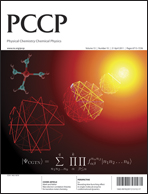Spin–orbit and spin–spin contributions to the zero-field splitting (ZFS) tensors (D tensors) of spin-triplet phenyl-, naphthyl-, and anthryl-nitrenes in their ground state are investigated by quantum chemical calculations, focusing on the effects of the ring size and substituted position of nitrene on the D tensor. A hybrid CASSCF/MRMP2 approach to the spin–orbit term of the D tensor (DSO tensor), which was recently proposed by us, has shown that the spin–orbit contribution to the entire D value, termed the ZFS parameter or fine-structure constant, is about 10% in all the arylnitrenes under study and less depends on the size and connectivity of the aryl groups. Order of the absolute values for DSO can be explained by the perturbation on the energy level and spatial distributions of π-SOMO through the orbital interaction between SOMO of the nitrene moiety and frontier orbitals of the aryl scaffolds. Spin–spin contribution to the D tensor (DSS tensor) has been calculated in terms of the McWeeny–Mizuno equation with the DFT/EPR-II spin densities. The DSS value calculated with the RO-B3LYP spin density agrees well with the D(Exptl) − DSO reference value in phenylnitrene, but agreement with the reference value gradually becomes worse as the D value decreases. Exchange–correlation functional dependence on the DSS tensor has been explored with standard 23 exchange–correlation functionals in both RO- and U-DFT methodologies, and the RO-HCTH/407 method gives the best agreement with the D(Exptl) − DSO reference value. Significant exchange–correlation functional dependence is observed in spin-delocalized systems such as 9-anthrylnitrene (6). By employing the hybrid CASSCF/MRMP2 approach and the McWeeny–Mizuno equation combined with the RO-HCTH/407/EPR-II//U-HCTH/407/6-31G* spin densities for DSO and DSS, respectively, a quantitative agreement with the experiment is achieved with errors less than 10% in all the arylnitrenes under study. Guidelines to the putative approaches to DSS tensor calculations are given.

You have access to this article
 Please wait while we load your content...
Something went wrong. Try again?
Please wait while we load your content...
Something went wrong. Try again?


 Please wait while we load your content...
Please wait while we load your content...